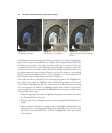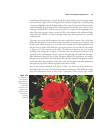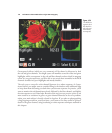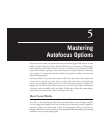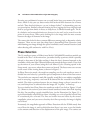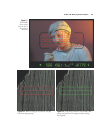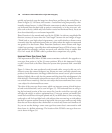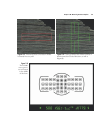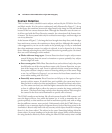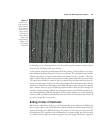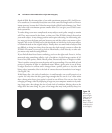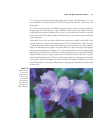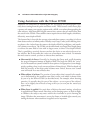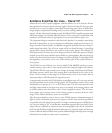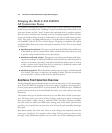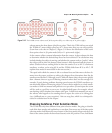Contrast Detection
This is a slower mode, suitable for static subjects, and used by the D7000 in Live View
and Movie modes. It’s a bit easier to understand, and is illustrated by Figure 5.7. At top
in the figure, the transitions between the edges found in the image are soft and blurred
because of the low contrast between them. Although the illustration uses the same ver-
tical lines used with the Phase Detection example, the orientation of the features does-
n’t matter. The focus system looks only for contrast between edges, and those edges can
run in any direction.
At the bottom of Figure 5.7, the image has been brought into sharp focus, and the edges
have much more contrast; the transitions are sharp and clear. Although this example is
a bit exaggerated so you can see the results on the printed page, it’s easy to understand
that when maximum contrast in a subject is achieved, it can be deemed to be in sharp
focus. Although achieving focus with Contrast Detection is generally quite a bit slower,
there are several advantages to this method:
■ Works with more image types. Contrast Detection doesn’t require subject matter
rotated 90 degrees from the sensor’s orientation to operate optimally. Any subject
that has edges will work.
■ Focus on any point. While Phase Detection focus can be achieved only at the points
that fall under one of the nine autofocus sensors, with Contrast Detection, any por-
tion of the image can be used. Focus is achieved with the actual sensor image, so
focus point selection is simply a matter of choosing which part of the sensor image
to use. As you’ll learn in Chapter 6, you can move the focus frame around on the
screen when working with Live View.
■ Potentially more accurate. Phase Detection can fall prey to the vagaries of unco-
operative subject matter: if suitable lines aren’t available, the system may have to
hunt for focus or achieve less than optimal focus. Contrast Detection is more clear-
cut. The camera can clearly see when the highest contrast has been achieved, as long
as there is sufficient light to allow the camera to examine the image produced by
the sensor. (The focus assist lamp can help when shooting subjects close enough to
the camera for the focus assist illumination to provide extra contrast.)
The D7000’s autofocus mechanism, like all such systems found in SLR cameras, eval-
uates the degree of focus, but, unlike the human eye, it is able to remember the pro-
gression perfectly, so that autofocus can lock in much more quickly and, with an image
that has sufficient contrast, more precisely. Unfortunately, while the D7000’s focus sys-
tem finds it easy to measure degrees of apparent focus at each of the focus points in the
viewfinder, it doesn’t really know with any certainty which object should be in sharpest
focus. Is it the closest object? The subject in the center? Something lurking behind the
closest subject? A person standing over at the side of the picture? Many of the techniques
for using autofocus effectively involve telling the Nikon D7000 exactly what it should
David Busch’s Nikon D7000 Guide to Digital SLR Photography138



